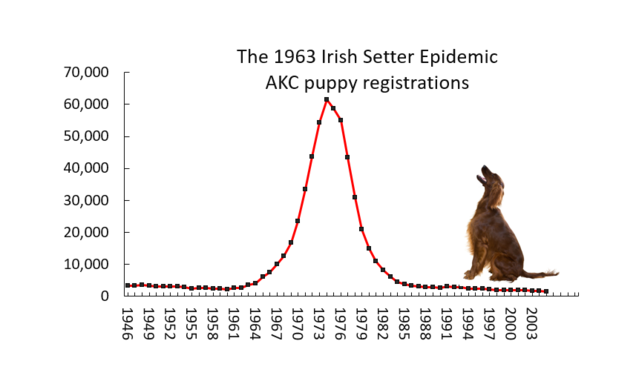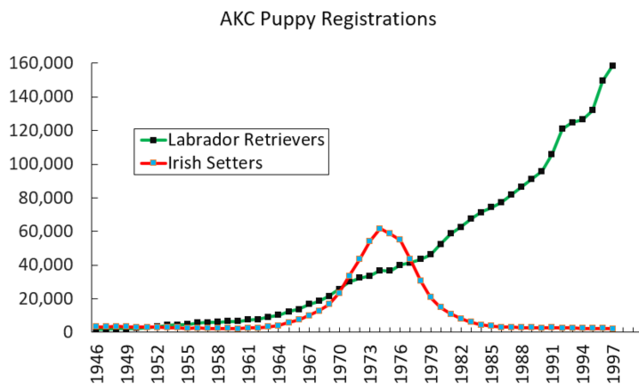Coronavirus Disease 2019
Viruses of the Mind: The Great Irish Setter Epidemic of 1963
Dog breed fads share some surprising commonalities with viral epidemics.
Posted March 31, 2020 Reviewed by Abigail Fagan

In a 1991 essay, the evolutionary biologist Richard Dawkins compared the spread of disease-causing viruses with socially contagious units of culture. He argued that these are passed from human minds to human minds via learning and imitation. Fifteen years earlier, in his book The Selfish Gene, Dawkins had named these hypothetical bits of cultural replicators memes.
There are, of course, profound differences between the spread of COVID-19 and the popularity of the infectious tune Old Town Road by Lil Nas X. Yet there are some surprising similarities in the dynamics of epidemics caused by germs, computer bots, and contagious cultural preferences. Take the short-lived enthusiasm for Irish Setters in the United States.
Originally bred as gun dogs, Irish Setters were among the first breed to be recognized by the American Kennel Club when it was organized in 1884. But for the next 80 years, Irish Setters were not particularly popular. In the post-war decades, the number of Irish Setter puppies registered with the AKC languished between 2,000 and 3,500 a year. By 1960, it had fallen to the 27th most popular breed in the United States.
The Irish Setter Epidemic
In the early 1960s, however, the popularity of the breed suddenly began to skyrocket. Between 1963 and 1974, AKC Irish Setter registrations jumped 1,500%, from about 4,000 puppies a year to over 60,000 dogs. And Irish Setters rose from America’s 27th most popular canine companion to number three. (Only poodles and German shepherds were more popular.) For a while, Setters were the proverbial “next big thing.” But fads are fickle, and the crash began in 1974. By 1986, AKC registrations had dropped 95%, to a little over 3,000 puppies, and the breed fell to 46th in popularity. (Now they rank 77th.)

Dog Breeds as Models of Social Epidemics
Fifteen years ago, the American Kennel Club sent me a very nice present. It was the number of new registrations for each breed for every year between 1927 and 2005 (60 million puppies). In a series of papers, my colleagues and I have used this information to examine how preferences for types of dogs spread across our cultural landscape. Here are some of the questions we have sought to answer.
Are Dog Breed Fads Really Social Epidemics?
In some ways they are. For example, dog fads follow the same patterns of growth and decline as disease epidemics. The first stage is slow growth. But when the tipping point is hit the second stage begins – explosive growth. In the final stage, both disease epidemics and social epidemics burn out.

How Common Are Dog Breed Epidemics?
Most of the 170 breeds in our data set never became popular. But when a breed goes viral, the results are spectacular. In the 1960s and 1970s, nine breeds suddenly skyrocketed to fame and then just as suddenly, their popularity collapsed. Annual Old English Sheepdog registrations, for example, jumped 10,000% in 14 years. The boom in Rottweilers was the most impressive. Beginning in 1976, they quickly jumped from 1,400 new puppies a year to 104,000 puppies.
How Long Do Dog Breed Epidemics Last?
We found that, on average, they last 27 years. Of the 9 breeds with the most pronounced boom-and-bust pattern, the boom phase lasted 14 years and the bust phase 13 years. During the peak of the Irish Setter social epidemic, puppy registrations were doubling every 18 months. (In contrast, as I write this, the doubling time for COVID-19 infections in California is 3 to 4 days.)
Why Do Some Breeds Suddenly Take Off?
In some cases, breed popularity is sparked by a movie. The tipping point for Irish Setters was caused by the release of Walt Disney’s Big Red, which starred an Irish Setter. In a study of dog movies released between 1927 and 2004, we found that the 10 most influential movies resulted in an additional 800,000 new puppy registrations for those breeds. (See The Dog Movie Star Effect: Is It Real?)
But most canine fads are not produced by a movie, and most dog movies do not produce a social epidemic. In a 2004 paper, Alex Bentley, Matt Hahn and I found that most shifts in the popularity nicely fit a “random drift model” of evolution. In short, breeds get popular mostly by dumb luck coupled with our proclivity to unconsciously copy what other people are doing. This theory also explains a host of other forms of pop culture. These include baby names, top 40 songs, skirt hemlines, and even Neolithic pottery styles.
Do “Better” Breeds Become Popular?
No. We found that breeds with lots of behavior problems were just as likely to become popular as breeds with fewer behavioral issues. And to our surprise, breeds with more genetic problems were more likely to become popular than breeds with fewer inherited disorders. The current craze for French bulldogs, a breed laden with genetic issues, is ample evidence that our choices in dogs often defy rational explanation. (See Why Do Dog Breeds With Genetic Disorders Suddenly Get Hot?)
Why Does A Hot Breed’s Popularity Usually Crash?
This is still a bit of a mystery. As a general rule, forms of pop culture that rapidly become popular subsequently show the steepest declines. This has been called, "the logic of fashion cycles." Jonah Berger of the University of Pennsylvania found that baby names that grew slowly in popularity had lasting power while names that got popular quickly were soon dropped. Using our AKC data,
Alberto Acerbi and his colleagues found this pattern was also true of dog breeds.

Labrador Retrievers are the best example of a slow but steady rise to success. They became America’s favorite breed in 1991, and after 30 years, they remain our nation’s top dog.
Some breeds, including Irish Setters, have characteristics that may facilitate particularly rapid falls from grace. This conclusion in base on dog owner ratings on the University of Pennsylvania's James Serpell's Canine Behavioral Assessment and Research Questionnaire. (You can add your dog to the C-BARQ database here.) Dr. Serpell has found that Irish Setters tend to have some irritating behaviors. They scored high in the C-BARQ categories of Chasing, Escaping/Roaming, Pulling on Leash, Hyperactivity, Food Begging, and Food Stealing. The 1990s fad in Rottweilers suddenly went south when insurance companies started canceling homeowner's policies of Rottweiler owners due to a dramatic increase in fatal attacks attributed to the breed.
Germs and Viruses of the Mind
The differences between the 2020 COVID-19 epidemic and the 1963 Irish Setter epidemic are vast. The epidemics occur on different time scales and geographic scales, and the costs in terms of human suffering are incomparable. But as evidenced by the vagaries of the rises and falls of dog breed popularity, there are similarities between epidemics caused by germs and those caused by viruses of the mind.
The good news that, sooner or later, they all burn out.
Stay safe.
References
Herzog, H. (2006). Forty-two thousand and one Dalmatians: Fads, social contagion, and dog breed popularity. Society & animals, 14(4), 383-397.
Herzog, H. A., Bentley, R. A., & Hahn, M. W. (2004). Random drift and large shifts in popularity of dog breeds. Proceedings of the Royal Society of London. Series B: Biological Sciences, 271(suppl_5), S353-S356.
Ghirlanda, S., Acerbi, A., Herzog, H., & Serpell, J. A. (2013). Fashion vs. function in cultural evolution: The case of dog breed popularity. PLoS One, 8(9).
Acerbi, A., Ghirlanda, S., & Enquist, M. (2012). The logic of fashion cycles. PloS one, 7(3).




